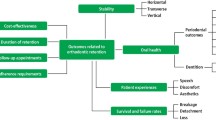Abstract
Data sources
Medline, Embase, Cochrane Oral Health Group's Trials Register, the Cochrane Central Register of Controlled Trials (CENTRAL), LILACS, BBO, ClinicalTrials.gov, the National Research Register and Pro-Quest Dissertation Abstracts and Thesis database.
Study selection
Randomised controlled trials (RCTs) and controlled trials (CCTs) in children under 11 years at the beginning of treatment for interventions including; interceptive extractions, space maintenance, crossbite correction and habit dissuasion were considered.
Data extraction and synthesis
Two reviewers independently extracted data and assessed study quality using the Cochrane Risk of Bias tool. Meta-analysis was possible for 11 comparisons.
Results
Twenty-two studies (18 RCTs, three CCTs) were included with 20 being considered to be at low or unclear risk of bias. For Class II correction in the short-term, meta-analyses demonstrated a statistically significant reduction in ANB (−1.4 degrees, 95 CI: −2.17, −0.64) and overjet (−5.81mm, 95 CI: −6.37, −5.25) with both functional appliances and headgear versus control. For Class II correction in the long-term, however, statistical significance was not found for the same outcomes. Treatment duration was prolonged with both functional appliances (6.85 months, 95 CI: 3.24, 10.45) and headgear (12.47 months, 95 CI: 8.67, 16.26) compared to adolescent treatments. Meta-analyses were not possible for comparisons of other interceptive treatments due to heterogeneity and methodological limitations. The overall quality of the evidence based on the GRADE assessment suggested that the level of evidence was low to moderate.
Conclusions
The results suggest a lack of evidence to prove that early treatment carries additional benefit over and above that achieved with treatment commencing later; however, this does not imply that early treatment is ineffective. The additional cost and burden to the patient, parent and clinician may, therefore, generally negate early treatment. Further trials of high quality of evidence are required assessing the effectiveness of interceptive treatment for a range of occlusal problems, particularly those not known to hinge on growth potential, with long-term follow up to ascertain whether short-term effects are maintained once growth has ceased and to delineate the effects of intervention timing on the overall treatment duration.
Similar content being viewed by others
Commentary
This publication focused on the long pursued question about best timing for orthodontic treatment. As some will likely debate this is a generally vague question that immediately will call for an ‘it depends on...’ answer.
The title should have therefore been a little more specific like ‘for patients that may benefit from interceptive treatment’. In any event, the reader quickly realises that this systematic review focuses on orthodontic samples that were treated before 11 years of age and compares them against untreated controls or alternative treatment approaches. In summary, this was an endeavor to answer the endless argument about one-phase vs two-phase orthodontic approaches.
Overall, this is a well-conducted systematic review with meta-analysis that followed generally accepted methodological guidelines. Although 20 RCTs or quasi-RCTs were finally included, the final GRADE conclusions (low to moderate) reflect several methodological issues in those studies. As such no conclusive evidence that a one-phase approach is necessarily better than a two-step approach could be advocated.
The selection of 11 years of age as cut-off may be questionable for those who consider that timing of the skeletal maturation adolescent spurt is a significant factor on orthodontic treatment timing for those malocclusions with a mandibular skeletal component. It can be considered that the provided reasoning is not a well-justified cut-off value that may or not influence the results and conclusions of this research effort. The authors seem to have selected that specific age because that is the usual age when full orthodontic treatment is started.
In general terms the conclusions of this review were:
-
Although some short-term statistical significant differences were noted for the earlier management of skeletal class II correction vs no treatment, the clinical significance of those changes is questionable. One exception may be OJ reduction when using headgear (almost 6 mm reduction). The long-term effects were non-significant for several cephalometric and occlusal variables. As expected earlier clinical management implied longer treatment times. Regarding skeletal class III management the ANB improvement was statistically and maybe clinically significant. A 3-degree ANB change may not be relevant due to the known limitations of the Steiner analysis. In maxillary deficient samples anterior cranial base size and inclination is likely affected.
-
Regarding anterior open bite correction the authors concluded that most of the changes are dentoalveolar in nature so that early treatment management may produce an aesthetic improvement, but not necessarily impact the underlying skeletal problem.
-
About unilateral posterior crossbite correction it seems that early dentoalveolar transversal treatment changes are stable, but those changes normally failed to attain normal untreated control values.
-
In regards to interceptive extractions without any further active intervention to relieve primary crowding it was found that only in around 23% of the included sample the crowding reduction was larger that 50%.
-
Finally, when considering improvement in the position or eruption of ectopic maxillary canines there is some evidence that maxillary expansion or molar distal movement improves the canine eruption path. It seems that generating dental arch space may be an important factor to facilitate maxillary impacted canine's eruption.
Author information
Authors and Affiliations
Additional information
Address for correspondence: PS Fleming, Department of Orthodontics, Institute of Dentistry, Queen Mary University of London, Turner Street, London, E1 2AD, UK. E-mail padhraig.fleming@qmul.ac.uk
Sunnak R, Johal A, Fleming PS. Is orthodontics prior to 11 years of age evidence-based? A systematic review and meta-analysis. J Dent 2015; 43: 477–486. doi: 10.1016/j.jdent.2015.02.003. Epub 2015 Feb 12. Review. PubMed PMID: 25684602.
Rights and permissions
About this article
Cite this article
Mir, C. One-phase or two-phase orthodontic treatment?. Evid Based Dent 17, 107–108 (2016). https://doi.org/10.1038/sj.ebd.6401201
Published:
Issue Date:
DOI: https://doi.org/10.1038/sj.ebd.6401201



